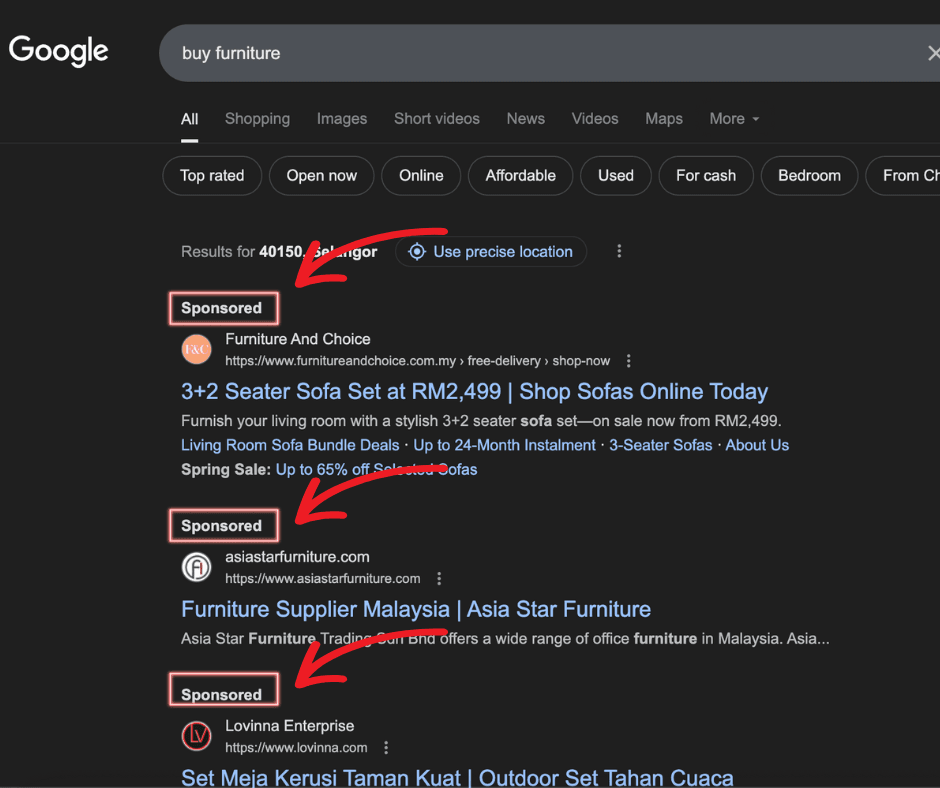
If you’re running a business in 2025, you already know how crowded the digital space has become. Getting your brand seen online is no longer just an option, it’s a necessity. But should you invest in SEO (Search Engine Optimization), SEM (Search Engine Marketing) or combine them as part of your broader digital marketing strategy? What’s the difference anyway? More importantly, which one actually brings better results for your business?
In this blog, we’ll break down what SEO and SEM are, how they work and when to use each ,or both to get the most out of your digital marketing budget.
What is SEO?
SEO stands for Search Engine Optimization, which is just a fancy way of saying: “Make Google love your website.”
Here’s how it works:

Imagine someone searches “shoe shop in malaysia” If your website is optimized with the right keywords, fast loading speed, mobile-friendly design and high-quality content — Google is more likely to show your site on the first page (maybe even the top!).
And why does that matter? Because hardly anyone clicks on Page 2.
With SEO, you’re not paying Google for clicks, you’re earning your spot through credibility, helpful content and solid website structure. Think of it like planting seeds: it takes time, but once your site gains trust, you’ll keep reaping the traffic without spending on ads.
How SEO works in action:
- You write useful blog posts answering your customers' questions.
- You optimize your website with keywords like “shoe shop in malaysia”
- You build links from reputable sites.
- Over time, Google sees your site as trustworthy and your ranking climbs.
In short: SEO helps people find you organically, right when they need you without paying for every click.
What is SEM?

SEM stands for Search Engine Marketing, and unlike SEO, this one comes with a price tag ,but instant results. Here’s the easiest way to understand it: Let’s say you want your business to show up right now when someone searches “top restaurant in malaysia” With SEM (usually in the form of Google Ads), you can pay to appear at the very top of search results, above the organic listings. It’s like skipping the queue and getting a VIP pass to the front of the line.
Once your campaign is live:
- You set your target keywords.
- You define your audience (location, age, device, etc.).
- You only pay when someone clicks your ad (called pay-per-click or PPC).
So why use SEM? :
- You get immediate traffic (great for launches or sales).
- You can test different messages fast.
- You only spend on clicks that matter.
But here’s the catch: once your budget is used up, your ad disappears. It’s like switching off a light. That’s why SEM is often paired with SEO for short-term results and long-term growth.

SEO vs SEM: What's the Main Difference?
The biggest difference lies in cost, speed, and sustainability :
- SEO takes time but pays off in the long run with compounding traffic.
- SEM delivers quick wins but requires continuous budget.
You can think of SEO as growing a tree, it takes effort, but once it’s strong, it gives shade (and traffic) for years. SEM, on the other hand, is like turning on a faucet, instant results but only as long as the tap (budget) is open.
Which Strategy Works Best for Your Business?
That depends on your goals, timeline, and budget.
If you’re launching a new product and need visibility fast, SEM gives you the edge, especially when supported by a well-structured Google Ads strategy. But if you’re building long-term authority and organic traffic, SEO is the way to go. In fact, a 2025 SEO ROI report revealed that industries like real estate saw a 1,389% return from SEO, while B2B SaaS earned 702%. These numbers show that while SEM provides instant traction, SEO can deliver massive long-term ROI, especially when aligned with your content and audience strategy.
Most businesses find a combination works best. For example, using Google Ads for immediate traffic and SEO to build sustainable rankings.
The Role of SEO and SEM in a Complete Marketing Strategy
Modern businesses rarely choose just one. Smart marketers understand that SEO and SEM play complementary roles:
- SEO builds credibility and trust over time.
- SEM captures short-term opportunities and specific campaigns.
Together, they create a balanced funnel, attracting top-of-funnel awareness through SEO and converting high-intent traffic with SEM.
Common Misconceptions

Many businesses fall into traps when choosing between SEO and SEM. Let’s clear up a few:
- “SEO is free.”
While you’re not paying for ad placements, SEO still requires investment — from producing high-quality content to using the right tools and dedicating time to ongoing optimisation.
- “SEM is too expensive.”
When managed well, SEM can deliver a high return on investment by targeting users who are already ready to convert. In fact, a 2025 study by Single Grain found that SEO delivers an average ROI of 748%, meaning for every $1 ( RM4.25) spent, businesses earned $7.48 (RM31.78) in return. That makes it one of the most cost-effective digital marketing strategies available today.
- “You have to choose one.”
Not necessarily. Many companies find the best results by combining both strategies — using SEO for long-term growth and SEM for immediate visibility.
Conclusion: Choosing the Right Path
There’s no one-size-fits-all answer. Whether it’s SEO, SEM, or both, the right strategy depends on your business size, industry, goals, and timeline.
If your business has time to invest and wants sustainable traffic, start with SEO. If you need fast visibility and immediate ROI, try SEM. If you want the best of both worlds? Combine them.
Curious how this applies to your business?
We’ve helped companies define the right strategy on our SEO and SEM for business guide.
Ready to grow with smarter search marketing? CollabPro offers tailored strategies that combine SEO and SEM to deliver results that matter.
Contents
Contents
Start Smart. Get the Right Traffic Strategy
We’ll help you find the best fit for your goals and budget.







